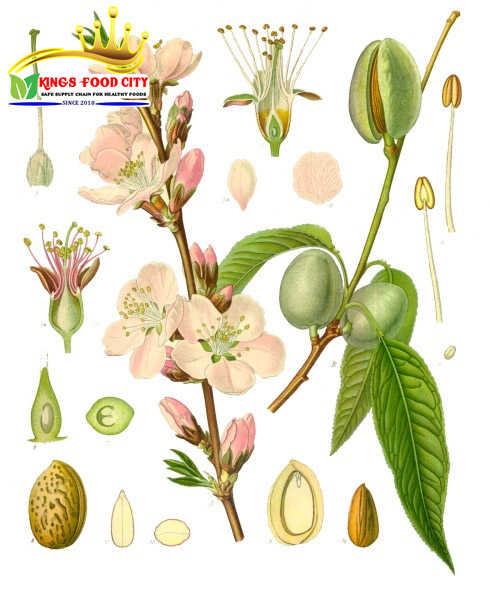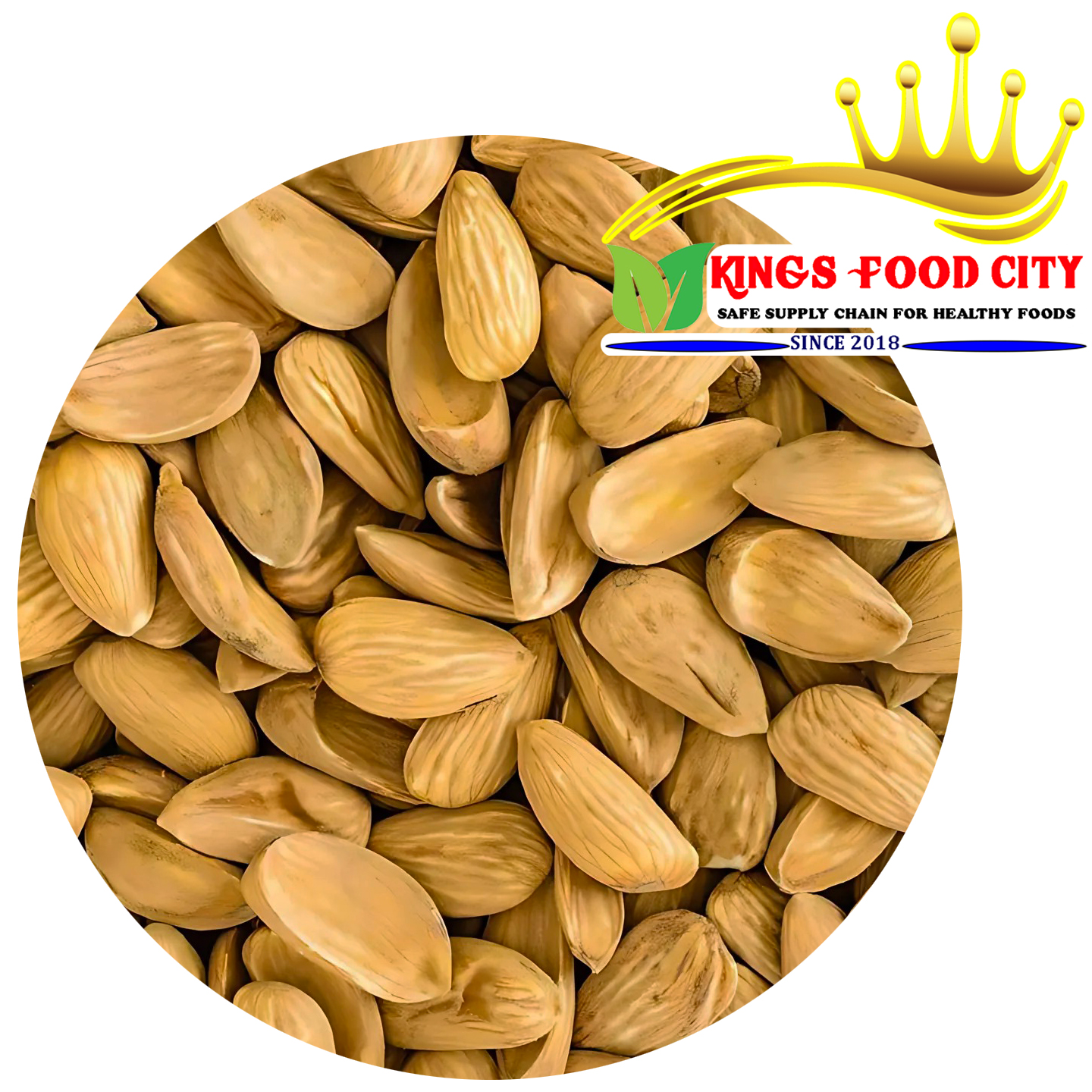History and Origin of Almonds
The history of almonds is a fascinating journey through time, culture, and agriculture. Almonds (Prunus dulcis) have been cultivated and consumed for thousands of years, contributing to both culinary traditions and the development of horticulture. Almonds have been revered since ancient times. Their origin can be traced back to the region of Western Asia, where the wild ancestor of the domesticated almond tree, Prunus dulcis var. dulcis, is believed to have originated. Archaeological evidence suggests that wild almonds were consumed as far back as 20,000 years ago, making them one of the earliest cultivated foods. Almond cultivation expanded from its origins in Western Asia to ancient Egypt, Greece, and eventually the rest of the Mediterranean. The ancient Egyptians left evidence of almonds in Pharaohs' tombs, indicating their cultural and ritual significance. The Greek philosopher-physician Theophrastus mentioned almonds in his botanical works around 300 BCE, shedding light on the plant's early recognition and usage. Almonds have held symbolic importance in various cultures. In regions around the Mediterranean, almonds were a symbol of fertility, and in some cultures, they were associated with good fortune and prosperity. In ancient Rome, almonds were customarily showered upon newlyweds as a fertility charm. As trade and cultivation expanded, almonds became a staple in the diets of people across Europe and the Middle East. The Moorish influence during the medieval period brought almond trees to Spain, leading to further propagation and integration into Spanish cuisine.

Brief History of Mamra Almonds and Unique Characteristics
Mamra almonds, also known as Mamraei almonds or Murmura in Hindi) hold a distinctive and revered place in the world of almonds. These premium almonds are famous for their unique characteristics and origins. Mamra almonds have a rich history deeply rooted in the valleys of Persia. The ancient cultivation and propagation of Mamra almonds have been an integral part of the agricultural traditions and cultural heritage of the region for centuries. The cultivation of Mamra almonds involves careful and traditional practices, often passed down through generations. The almonds are grown in arid and semi-arid regions, benefiting from the unique climate and soil conditions that contribute to their exceptional quality and flavor.
Mamra almonds are a exceptional type of almond that manages to stand out from all the others. This is due to its distinctive shape, being long and slender with a delicately curved tip that gives it a truly luxurious appearance. It is a historical fact that Mamra almonds were mainly reserved for royalty, which only adds to their prestigious charm. Even today, Mamra almonds remain one of the most highly-priced almond varieties in the market, and for a good reason. These almonds are known for their exquisite flavor profile, which can be described as rich and nutty, with a delightful crunch which makes them highly favored among almond lovers. Their exceptional texture and flavor are due to the fact that Mamra almonds are much crunchier and crisper than other types of almonds, giving them a distinct snack-like appeal. Furthermore, they are lighter in weight than other almond varieties, which also adds to their unique characteristics. Even though Mamra almonds are notably more expensive than other almonds, they carry the same nutritional benefits, and in fact, contain almost twice as much monounsaturated oil, which helps to regulate cholesterol levels. Nevertheless, the production of Mamra almonds is quite expensive and time-consuming, which is why they account for only 5% of the world's total almond production.
Mamaei almonds, with their wooden shells, have a shelf life of more than 5 years and maintain their quality for a longer period compared to other almond varieties if stored under appropriate conditions. For short-term storage (a few weeks), almonds should be kept in a dry and cool environment (between 0 to 2 degrees Celsius). However, long-term storage requires refrigeration with a relative humidity of 60-65%, reduced oxygen content of around 5%, and a temperature of 0 degrees Celsius. Due to their high oil content, these almonds can absorb odors and flavors from the surrounding air. Therefore, almond kernels should not be stored near other odorous products such as onions, vegetables, or other items with strong odors.
Mamaei almonds, with their wooden shells, have a shelf life of more than 5 years and maintain their quality for a longer period compared to other almond varieties if stored under appropriate conditions. For short-term storage (a few weeks), almonds should be kept in a dry and cool environment (between 0 to 2 degrees Celsius). However, long-term storage requires refrigeration with a relative humidity of 60-65%, reduced oxygen content of around 5%, and a temperature of 0 degrees Celsius. Due to their high oil content, these almonds can absorb odors and flavors from the surrounding air. Therefore, almond kernels should not be stored near other odorous products such as onions, vegetables, or other items with strong odors.

Different Grades of Mamaei Almond Nuts:
Grade 5A: the largest grade of Mamaei almonds and there are 80 to 85 kernels per hundred grams.Grade 4A: about 90 to 95 almond kernels in per 100 grams.
Grade 3A: about 100 to 105 almond kernels in 100 grams.
Grade 2A: about 110 to 115 almond kernels in 100 grams.
Grade A: about 120 to 125 almond kernels in 100 grams.
ES grade: about 130 to 135 almond kernels in 100 grams.
Mini grade: There are about 160 and more almond kernels in 100 grams of this grade.
Mamra Almonds vs. Normal Almonds
Mamra almonds are absolutely unique and not your typical almond. They are different from California almonds due to their distinct shape, exquisite taste, and nutrient profile. These nuts have an amazing cervical shape that sets them apart from regular almonds. They are also super crispy, making them the perfect snack for anyone. It is no surprise that Mamra almonds are among the most expensive nuts in the market, constituting just 5% of the total almond production in the world. You can easily differentiate them from regular almonds because Mamra almonds have a cavity on the front, while normal or California almonds have a convex shape on both sides.
Although regular almonds are considered sweeter and more delicious, Mamaei almonds have a host of amazing benefits that make up for their slightly less sweet taste. Did you know that they are ten times more nutrient-dense than regular almonds? They are packed full of nutrients, making them an amazing addition to your diet. However, it is important to note that pasteurized almonds, which are often used to make almond oil, can lack some of the nutrients found in their natural state.
Mamra almonds tend to be more slender compared to regular almonds, which are typically large and round with very little fat. These almonds are packed with tons of vitamins such as Vitamin E, magnesium, manganese, protein, fiber, and antioxidants. With all the health benefits they offer, Mamra almonds are undoubtedly one of the healthiest nuts you can incorporate into your diet.
Several Health Benefits of Mamaei Almonds
One of their most unique features is that they contain zero cholesterol, making them a great choice for maintaining heart health. The high concentration of monounsaturated oils in these almonds is what makes them so good at reducing bad cholesterol levels while simultaneously promoting an increase in healthy cholesterol.
But the health benefits don't stop there! Mamra almonds are also known to be excellent for improving brain function. Indian families have long believed that almonds are great for the neuron system and promoting overall brain health. And with Mamaei almonds being rich in several important nutrients that work to alleviate stress on the nervous system, it's no wonder they are considered an effective way to boost mental efficiency.
If you're looking to improve your heart health, Mamra almonds may be exactly what you need. Their anti-inflammatory properties are crucial in maintaining a healthy heart and preventing various cardiac disorders such as heart attacks and strokes. Let's not forget about their bone-strengthening abilities, as they are a great source of calcium and magnesium.
Last but not least, Mamra almonds are also beneficial for the digestive system. They can help to improve digestive tract function and promote softer bowel movements, thanks to their high fiber content. But as with all things, it's important to consume them in moderation to avoid any unwanted digestive disorders.

